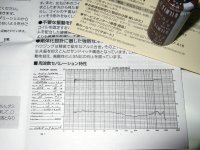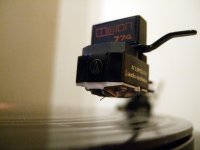You affirmation about the 33 series which I was eying for a while helped to tip the scales so I took the decision to finally try one out. It came in from Japan today. Its the AT-33PTG/II. Took enough work to reset the arm about right when moving on from the Denon. Seems VTA sensitive and load sensitive. There are still some geometrical details I want to revisit. Only few Lps I played as for now. Nonetheless it greets with a realistic and smooth nature along with very good tracking, throws a wide sound not in expense of ambient clues leading to enhanced resolution. Circa 150 Ohm load looks its a comfort zone. But its very early to fix the set up or to know all details. Feels like a modern, neutral enough but not cold cart which hints to the better ($$) categories for less. Of course not with bombastic vintage colors and thickness of tone like Denons in the bit rough or in all glory like with SPUs, but honest and grainless. More like a Lyra sound but to the cooler and bit less colorful side of things.
Congrats Salas nice cart
Cool, give it some hrs (mine loosened afte about 50ish)
150ohm load, could be ideal yes, have tried higher but settled at 100 in my previous Riaa (P-075mk2) it dident have a 150ohm setting thou.
When you where testing load below and above 150 how did it affect the sound ? (im still in doubt about the amount of bass , not to worry)
It is fun to see how detailed the simplistic are, the resolution is massive but its still not all all "analytic" its just playing music
Fun
Below 150 at ~130 (3rd DIP position 1K ON too) it grows bigger in presence losing some focus, more so in 100 but with more treble too (1st position ON only). Fully open at 47K (all positions OFF) grows wide and stronger dynamically (output gains), retaining good focus, but loses bass fundamentals relative volume, typical bass players start sounding little like Jaco Pastorius trombone 2nd harmonic style tone. It would be best dynamically run open for exploitation in a multiway system with actively controlled bass area, so we boost there and compensate. The frequency response I measured follows the manual's FR chart very nicely BTW. Build, finish, and spec are generally of a quality product, not budget like at all.
Congrats Salas nice cart
I am always keen to try and describe or recommend good budget carts which most of us need to know more about so to exploit our builds better. This model is not that known or common in the West either. Thanks. The FSP proves showing everything little with ease nonetheless, very easy to reveal set up details and various carts through it. Rather highlights the better aspects and its tolerant to the lesser aspects. I agree with Per on that as he wrote above.
P.S Its useful compliance for arm calculations looks like 18-20cu by European standard when calculating back from resonance as seen in the Fast Fourier. The brass screws and nuts included are substantial adding 1.5g per shorter pair or 1.9g per longer pair. The cartridge itself is dead on spec 6.9g. I used aluminum screws since I had enough mass from the silicone stuffed arm wand already.
Attachments
What do you mean you can't find? Physically or you don't get any voltage on them?
Physically,
Well, I need better glasses
Thanks
Last edited:
Physically,
Well, I need better glasses
Thanks
It triggered an opportunity though. We explained what if and why when no PT1 PT2 dif voltage or very little is registering after Presbel discussed what had occurred during his adjustments.
I am looking through my parts bin to find some nice brands of not too big caps and a good in Early voltage and HFE pair of NPNs capable of circa 0.1A bias for a second order classic capacitance multiplier duet on a smallish matrix board to fit near the DC inputs, which is easy to make and test since I just got the simple raw supply with 180mV pk-pk ripple, no RC, no rail extras, but when I disconnect the TT I hear no kind of buzz only mild hiss (mainly from the load resistor, if I short the input 80% goes) with the volume full up. Hmm, I hope it will change something to the better in resolution or ambient cues at least. Or to just interfere with the dynamics, in that case I can keep it for other uses. Its a handy filter cell anyway. Did you manage Kean's low Zout multiplier anybody by now?
It triggered an opportunity though. We explained what if and why when no PT1 PT2 dif voltage or very little is registering after Presbel discussed what had occurred during his adjustments.
Well after "finding" TP1 and TP2, I installed Q1 and Q6, did a final overall check, cleaned excess solder flux, connected all the needed probes (2 DMM and osciloscope), and turned on PWS, as expected LEDs turned on, the second bunch with a little delay, and I got a clean osciloscope wave.
After some adjusting on VR2 I got perfect 3,6V and on Rail+ I have 31,79V which I believe is acceptable.
During the WE will mount everything on the chassis (if they arrive), will check all again, take some pictures for posting and then connect to my new DIY PTP type Lenco TT installed with The Wand+ carbon fiber unipivot tonearm. For the time being will run it with an Ortofon 2M red, still struggling to decide which cart to buy on the 500€ region, today a bit inclined for a Dynavector 10X5...but still don't know.
Thanks Salas for your efforts, thanks all the others involved, TeaBag, Ricardo, Merlin, etc.
Last edited:
Correct, I went for the 43db version. Latter if need I can upgrade or use in-house setup transformers. I will look for the US supplier for the cart.Nice, we will see construction pictures soon then. You made the 40 or 43dB configuration? For the Dyna better find a trader in US$ it comes down to an equivalent of around 330 Euro that way.
Last edited:
Better avoid transformers when you will want to try MC or LMC since its only a matter of very few parts changing to convert the FSP for gain. Unless you want to benefit from balanced impedance primary floating transmission. That gives common mode rejection to all the nasty things noise from nearby equipment and mains cables that couple to a strong magnet low signal cart and its single ended cable run. Really good balanced primary SUTs cost much, or are very difficult to self make precisely, interfere a bit also. Still with a 2.5mV 150 Ohm cart like the 10X5 and 43-46dB gain those noise coupling things will be pressed down very low, and its a good source impedance for a JFET to see.Correct, I went for the 43db version. Latter if need I can upgrade or use in-house setup transformers. I will look for the US supplier for the cart.
I am looking through my parts bin to find some nice brands of not too big caps and a good in Early voltage and HFE pair of NPNs capable of circa 0.1A bias for a second order classic capacitance multiplier duet on a smallish matrix board to fit near the DC inputs, which is easy to make and test since I just got the simple raw supply with 180mV pk-pk ripple, no RC, no rail extras, but when I disconnect the TT I hear no kind of buzz only mild hiss (mainly from the load resistor, if I short the input 80% goes) with the volume full up. Hmm, I hope it will change something to the better in resolution or ambient cues at least. Or to just interfere with the dynamics, in that case I can keep it for other uses. Its a handy filter cell anyway. Did you manage Kean's low Zout multiplier anybody by now?
As I claimed, I have the exact same phenomenon when I disconnect my TT. Wander too if someone got tested properly build K Multiplier.
About the AT 33PTG II; try easing up the load, I had good results with 300-475 ohm, 220 ohm took away some of the fun...(in my system, on another riaa).
Arne K
I will give it a go up and down the scale again when it will have 50hrs on it. Got the 300 & 430 Ohm ability too in the DIP switch. TT & rest of system tonal synergy are big factors though. How do you like this cart in general?
Changed input load to 200ohm, the plan was to see if the midbass could be reduced
Went from 100ohm naked Z-foil to a 200ohm Dahle cmf55
The change was as expected , a little less midbass along with the other disadvantages you could expect going from a excellent resistor to a fairy ok resistor,
The bass peak is less prominent along with some reduced lower bass,
Not good to say how much is because of the change in value VS how much is because of the change in quality.
For those who are interested the CMF55 has some artifacts in the treble (distortion) the sound-stage is smaller and the lower bass is less detailed
Will order 150ohm and 200ohm in naked Z-foil,
Went from 100ohm naked Z-foil to a 200ohm Dahle cmf55
The change was as expected , a little less midbass along with the other disadvantages you could expect going from a excellent resistor to a fairy ok resistor,
The bass peak is less prominent along with some reduced lower bass,
Not good to say how much is because of the change in value VS how much is because of the change in quality.
For those who are interested the CMF55 has some artifacts in the treble (distortion) the sound-stage is smaller and the lower bass is less detailed
Will order 150ohm and 200ohm in naked Z-foil,
Turbon, it is likely that the rubber suspension in your P8ES has gotten stiff.
I offer a service to replace that rubber with a variety that lasts.
The cartridge also gets retuned.
This is interesting Joachim. Could you PM me some details with price, round trip time and maybe some references
Regards
- Home
- Source & Line
- Analogue Source
- Simplistic NJFET RIAA

